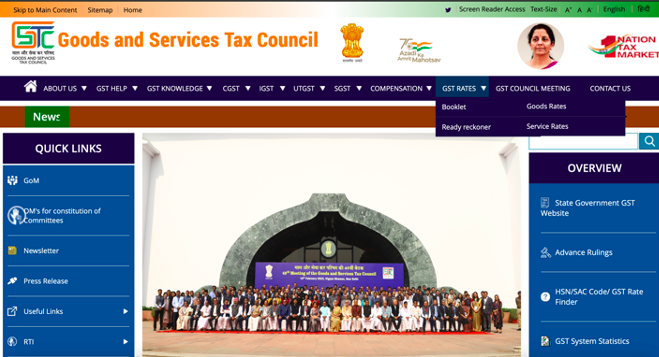
Website of the GST Council home page
India adopted a new tax administration on July 1, 2017, which they named the Goods and Services Tax (GST). This administration replaced the extant tax administration, named Value Added Tax (VAT), which was operative from April 1, 2005 to June 30, 2017. Attuned to the vast informal economy of India, the VAT administration instituted safeguards to protect cash-based market clusters. One way this was achieved was by levying taxes across the production of a commodity from the producer to the consumer. An unintended effect of this incremental taxation was a blurring of the distinction between goods and services. The form this blurring took was in levying taxes on services—registered here as entities, people, or more specifically, actions of people—that enabled the possibility of producing end products, known as goods. This created confusion because there was never a rigorously outlined mechanism through which taxes levied on goods could be differentiated in any meaningful way from taxes levied on services. This puzzle, which had been a blindspot of the VAT administration, was carried forward by the GST. The new GST brackets the taxes that accrue at each stage of the production of a good, instead consolidating taxation at the point of the good’s sale to the consumer.
Additionally, as the first administration of taxes in India to be conducted exclusively online, the GST represents an attempt by the government to digitize governance; in this instance, via the taxes it levies. In other words, the GST departs completely from a paper form of administering taxes. How are these two threads—the blurring of the distinction of goods and services, on the one hand, and the digitization of taxes and governance, on the other hand—connected? Who does this connection serve?
My interest in this essay is with the particular form of citizenship that paying taxes enacts. A dominant implication of digitization is that access to the internet has become a pre-requisite to perform taxed-citizenship in India, and the restriction of access creates difficulties in authenticating taxed-citizenship. Those who are economically able to access the internet can prove they are taxed-citizens of India. The rest, it would seem, are squeezed out.
Attentive to this hurdle, the government has instituted online payments as the default mode of economic exchange, with schemes such as Unified Payments Interface (UPI) which provides mobile devices to those without means so that they are able to make and receive payments online, as Nalin Mehta (2023) shows. Schemes such as UPI allow us to think more deeply about preliminary efforts made by the government to digitize its operations in 2008, with the introduction of the Unique Identification Authority of India (UIDAI) under the name Aadhaar, which enforced the collection of biometrics and iris scans of all registered citizens. Aadhaar is a number issued on a card that consolidates documentation of citizenship for the holder of the card. As Lawrence Cohen describes, the Aadhaar number grants access for the holder to governmental schemes and thereby ensures “service delivery” (2019, 483). Specifically, Cohen is astute to point to use of the term “service” with respect to governmental schemes. He draws attention to a book published by the founder of Aadhaar, Nandan Nilekani (2009), which suggests that the government of India imagines itself to be performing a service for those whose earnings fall below the (frankly rather arbitrarily designated) poverty line. Cohen shows that positioning governmental schemes as a service affords a widening of the concept “service” in ways that resemble wage, payment, and gift. The GST further entrenches this idea of service into the conceptual projection of the idea of a good by enforcing the technologies that are constitutive of its functioning. Thus, if we take seriously Cohen’s argument that Aadhar grants entry to those registered into governmental schemes, we see a deepening of the blurring of goods and services.
Canay Özden-Schilling remarked in a session titled Optimal Futures: New and Old Economies in a World of Data (December 2019) that “there has been much interest in how economists constitute the social, but far less in the unsuspected experts of everyday economies who fuse together worlds of bits and atoms.” In her book, Özden-Schilling argued that the datafication of the electricity trade makes allowances for the entry of nonspecialists by virtue of their specialization in data, whose presence produces specific economic relationships of electricity with data (Özden-Schilling 2021, 62). It is this relationship of data to electricity and economic activity that allows her to depart from existing framings of “the social” as constituted by economists towards a more robust understanding of the fusing of bits and atoms as performed by everyday economies (ibid.). In the same session, Miriam Posner (UCLA), in thinking across global supply chains, remarked that “the giants of this system—manufacturers and distributors—are often criticized for admitting to have little knowledge about the critical components of these chains,” and that “perhaps this ignorance is not feigned, but rather a built-in feature that is supposed to enable speed and efficiency.”
Combing through the archival and promotional materials on the website of the GST Council, one sees this deliberate ignorance playing out in how goods are distinguished from services. For instance, the Central GST (CGST) Act of 2017 defines goods as “every kind of movable property other than money and securities but includes actionable claim, growing crops, grass and things attached to or forming part of the land which are agreed to be severed before supply or under a contract of supply” (CGST Act 2017, 6) and services as “anything other than goods, money and securities but includes activities relating to the use of money or its conversion by cash or by any other mode, from one form, currency or denomination, to another form, currency or denomination for which a separate consideration is charged” (CGST Act 2017, 10).
The foregoing distinction of goods from services as it is elaborated in the CGST Act of 2017 suggests that a much more robust distinction is necessary in order to arrive at a concrete explanation for the difference in rates of taxation between them. Instead, Posner’s description as it relates to the GST might be taken to be gesturing towards a presumed digital accuracy of taxation. This presumed digital accuracy rests on the assumption that the GST is a self-regulating tax administration. This assumption, however, has amplified uncertainty in distinguishing a good from a service when legislating on, for instance, welfare schemes. Transactions implicate the circulation of goods, people, and things from producer to consumer. However, as the CGST Act 2017 shows, “services carried out by an employee to an employer in the course of or in relation to their employment; services by any court or tribunal established under any law for the time being in force; administrative duties performed in aid of the governance; funeral services; sale of land and actionable claims other than lottery, betting and gambling will be taxed neither as goods nor services” (CGST Act 2017, 103). There is therefore an unstated distinction between services that pertain to money versus services that pertain to employment. The blurring of the line between goods and services, on one hand, and the government’s efforts at digitizing its administration, on the other, allows us to ask the following questions. How might this digital footing of taxation constitute the career of India? What kind of life does this digital record have?
Returning to Özden-Schilling’s comments, we may also ask what kinds of nonspecialists-of-tax-but-specialists-of-data this tax administration seeks. A bit of background on the implementation of this tax will prove instructive. Rumblings of the new GST first came to prominence in the year 2000, spearheaded by the Kelkar task force on indirect taxation. This taskforce was set up under the right-wing Bhartiya Janta Party (BJP) administration, led by Atal Bihari Vajpayee. Following the general elections of 2004, there was a shift in government from BJP to left-wing Dr. Manmohan Singh-led Congress, under whom interest in the GST was renewed. Following the general elections of 2014, when government changed back to the BJP, Narendra Modi and his cabinet made the implementation of GST a priority. The Modi led-BJP, as we may glean from the website of the GST Council, based their choices on specialists of data that were sympathetic to the ideology that the right wing represents in India today, and chartered accountants who refrained from expressing an opinion on the government of the day.
There is a dark underbelly that underwrites this digitization of tax records. Increasingly, one finds the use of these records by government officials to target opponents of the ruling party of the government. The overlap mentioned above is serving the government in the following way. Digitized tax records have been marshaled by the government to target critics of the ruling party, such as the recent income tax survey of a popular non-partisan think tank, the Center for Policy Research (CPR). Previously, the government had used tax records and biometric information to force minority communities living in India for decades—sometimes centuries—to produce documentation of their citizenship. While this model of taxation may be more consistent with transactions elsewhere in the world, the uses to which it has recently been put show that while increasing digitization may enable the appearance of greater transparency, it also allows for a more sustained and efficient targeting of opponents.
References
Cohen, Lawrence. 2019. “The Social, De-Duplicated.” Journal of South Asian Studies .42(3): 482-500.
Mehta, Nalin. 2023. India’s techade: Digital Revolution and Change in India’s Largest Democracy. New Delhi: Westland.
Nilekani, Nandan. 2009. Imagining India: The Idea of a Renewed Nation. New York: Penguin Books.
Özden-Schilling, Canay. 2021. The Current Economy: Electricity Markets and Techno-Economics. Stanford: Stanford University Press.
Tushar Mehta is a fifth-year PhD student in the Department of Anthropology at Johns Hopkins University with an interest in economic anthropology and taxes in India. He also is an avid listener of improvised music, reader of detective novels, and drinker of specialty coffee.
Cite As: Mehta, Tushar. 2023. “Taxing Data” In “data/Big Data in the field” edited by Naveeda Khan, American Ethnologist website, December 22 2023, [https://americanethnologist.org/data-big-data-in-the-field/taxing-data/]




